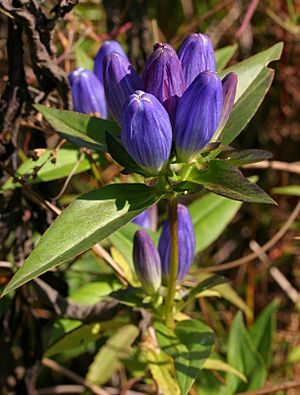Bottle gentian facts for kids
Quick facts for kids Bottle gentian |
|
|---|---|
 |
|
| Closed bottle gentian (Gentiana andrewsii) | |
| Scientific classification | |
| Genus: |
Gentiana
|
| Species: |
andrewsii
|
The Bottle Gentian (Gentiana andrewsii) is a special kind of flowering plant. It is also called the closed gentian or closed bottle gentian. This plant is part of the gentian family. It grows naturally in northeastern North America. You can find it from the Dakotas to the East Coast. It also grows across eastern Canada.
What Does It Look Like?
The Bottle Gentian blooms in late summer. This is usually from August to October. Its flowers are about 2 to 4 centimeters long. They are often a rich blue color. The flowers are shaped like bottles and stay closed at the top.
These flowers grow in clusters. You can find them at the very top of the plant. They also grow where the top leaves meet the stem. The stems are about 30 to 60 centimeters long. They tend to sprawl out, with flower clusters at their ends. The leaves are smooth and have a shiny look.

Who Named This Plant?
This plant was named after Henry Cranke Andrews. He was an English artist and engraver who studied plants.
Where Does It Grow and How Does It Live?
The Closed Bottle Gentian grows in different types of open grasslands. These include wet or somewhat dry prairies. It also likes prairie fens, which are a type of wetland. It mostly grows in rich, loamy soils. However, you might also find it in sandy places. For example, it can grow near the shores of the Great Lakes.
The flowers of the Bottle Gentian stay closed. This makes it hard for many insects to get inside. Only strong insects can push their way in to find pollen or nectar. Some large bumblebees, like Bombus fervidus, can do this. The digger bee Anthophora terminalis can also enter.
Sometimes, the eastern carpenter bee will chew a small hole at the bottom of the flower. This lets them "steal" nectar without helping to pollinate the plant. This is called nectar robbing. These holes can also help smaller insects. They can then get to the nectar and pollen too. This includes honeybees and some green sweat bees.
The Bottle Gentian is considered a threatened plant in some places. This includes the US states of New York and Maryland.

